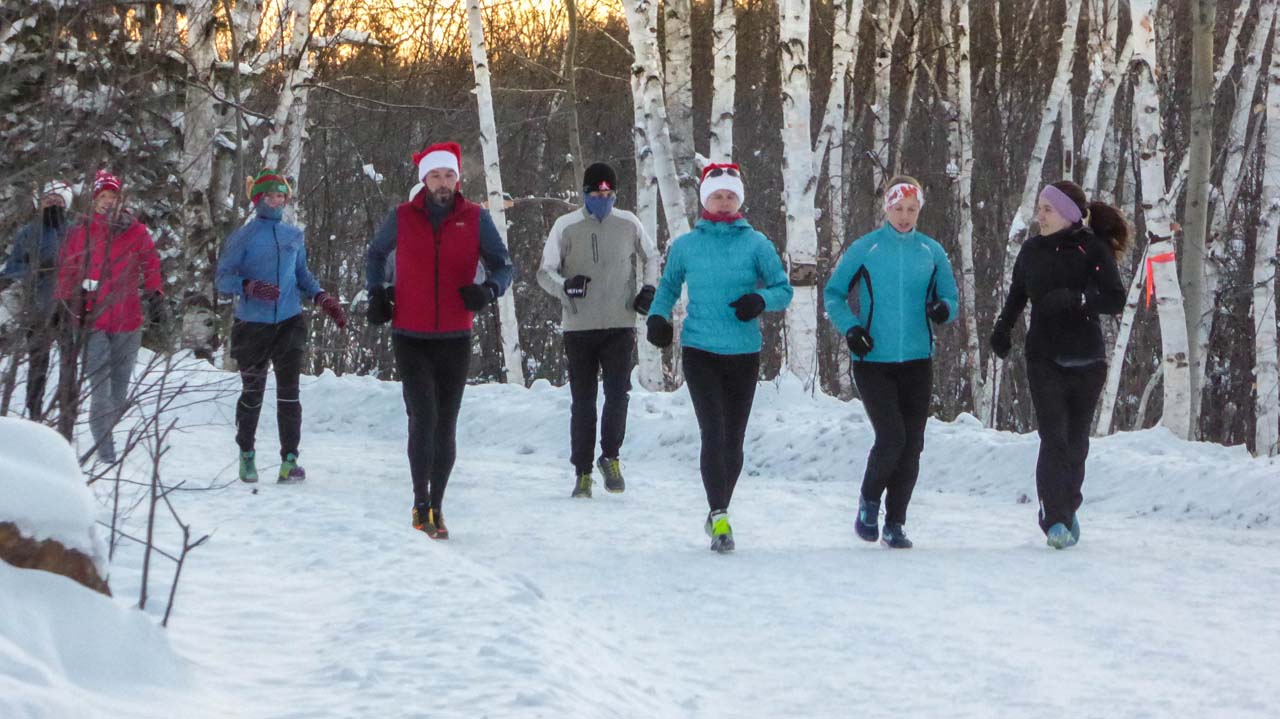|
It takes some practice to learn
what to wear for running outdoors at different temperatures
in winter, just as in spring, summer or fall. To save
you some of the guesswork, we share the benefit of our
experience with how to choose pieces from your gear stash
based on what the thermometer says. Keep in mind that
everyone is different, and with practice you’ll
learn exactly what you need to be comfortable at different
temperatures.
Note that in winter, you
should feel cool when you start, and you’ll warm
up as you go (it’s not called a warmup for nothing).
If you can stand outside for five minutes without getting
cold, take off a layer. Overdressing for the conditions
can sometimes be worse than underdressing.
Hat or no hat?
Note: people have strong feelings about headgear. If you’re
a hat person, the choice becomes, at what temperature
do you switch from a peaked hat or ball cap to a toque
(for us it’s around 0 C). If you hate hats, you’d
be wise to wear something on your head–even if it’s
just a headband or a buff–when the mercury goes
below -5 C or so.
Layer up
The best way to dress for cold weather is to layer technical
fabrics, for maximum warmth and breathability. Many people
swear by merino wool base layers, since merino is warm,
naturally wicks away moisture and doesn’t harbour
bacteria or odour. Some companies are even coming out
with technology that adapts to your activity level, keeping
you comfortably warm without overheating.
Keep your tootsies warm
You’d think that the activity of running would keep
your toes from freezing, but at -10 or below, it can be
a challenge to keep your feet comfortably warm. Definitely
consider layering your socks (two thin layers are warmer
than one thick layer), and if you do a lot of very cold-weather
outdoor running, consider investing in a shoe designed
for the purpose.
10 C
(balmy, by winter standards): We realize that if you live
in Vancouver, this counts as cold. For everyone else:
half-tights or capris are fine (or even shorts, if you’re
brave). Short or long sleeves, depending on your preference.
Jacket definitely not necessary (unless it’s raining,
in which case you might prefer a light shell over your
short-sleeve). Gloves not usually necessary.
2 C (still
relatively mild): A long sleeve, possibly over a tank
or short-sleeve, with half-tights, full tights or capris,
ball cap and thin gloves.
0 C
(freezing, but not really
that cold): A light long sleeve base layer under a warmer
half-zip-style long sleeve, hat or buff and gloves.
-5 C
(coolish): A light layer or two plus jacket, tights, toque,
and consider a neck warmer or buff if it’s windy,
and warm gloves. (We like to layer a pair of thin gloves
under windproof overmitts. Sometimes the overmitts come
off as we warm up.) Consider layering a pair of long shorts
or capris over your tights to keep your rear end warm,
or invest in some fleece-lined running tights.
-10 C
(cold): This is where some folks in southern Ontario draw
the line. If it’s colder than -10, they don’t
go out. If you do go out, dress warmly with at least 2-3
layers on top (including jacket), and a warm hat and gloves.
If your hands get cold easily, consider using hand warmers.
-20 C (extremely
cold): Layer up, and cover any exposed skin (remember
faces, wrists and ankles). Add some long underwear/merino
base layer bottoms under your tights. A balaclava and/or
neck warmer are strongly recommended.
-30 C (you
are in the north now): Add some vaseline to exposed areas
and you'll be fine. (Some runners stay in).
-40 C
(or colder) If your car will start
go for a drive. You will undoubtedly observe a few icycled
fanatics trudging merrily down the streets. They will
be wearing everything available from their running stores.
(Only the newbies will get frostbite).
Note: Whatever you do, don’t run
in a puffy vest. Your extremities may need extra clothing,
but your core is likely to overheat. And when you inevitably
want to tear off that vest, you can’t tie it around
your waist, so good luck carrying it home.
|










219.jpg)






